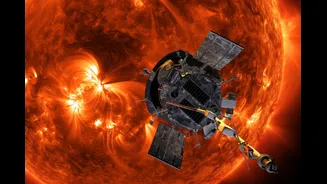Simulating Space's Challenges
The realm of space presents a multitude of obstacles that make it incredibly difficult to navigate. Astronauts must endure significant challenges, including
the absence of gravity, intense radiation exposure, extreme fluctuations in temperature, and the necessity to sustain themselves in environments devoid of air and resources. To adequately prepare for these factors, scientists and engineers have developed sophisticated simulators that replicate these harsh circumstances on Earth. These simulations are absolutely essential for training astronauts, testing equipment, and assessing the potential impact of space travel on both humans and machines. These simulations vary widely, encompassing everything from enormous vacuum chambers that mimic the void of space to advanced virtual reality systems capable of creating the experience of zero gravity. Through the utilization of these simulation systems, scientists can systematically investigate the various effects of space travel and develop the solutions required to mitigate the dangers of space exploration and increase its safety.
Replicating Zero Gravity
One of the most defining characteristics of space is the lack of gravity, or weightlessness. This environment significantly impacts all aspects of human health, from bone density to muscle strength. To counteract these effects, scientists utilize several methods to reproduce zero-gravity conditions for both training and research. One common technique involves the use of parabolic flights, where specially modified aircraft fly in a series of ascents and descents that generate brief periods of weightlessness. These 'vomit comets' allow astronauts to experience freefall conditions, enabling them to acclimatize to the environment of space. Another method employed to replicate zero gravity is underwater training. Astronauts and equipment are submerged in large pools where they can be suspended using specialized gear, closely replicating the conditions experienced during spacewalks. Neutral buoyancy in water simulates the feeling of weightlessness, permitting astronauts to practice maneuvers in the same way they'd execute them in space. These techniques help scientists investigate the physiological effects of zero gravity and to develop countermeasures to ensure the health of astronauts during space missions.
Extreme Temperatures & Vacuum
Space presents extreme temperature fluctuations, where direct sunlight can generate immense heat, while the absence of an atmosphere allows for rapid cooling. To simulate these conditions, scientists use specialized vacuum chambers. These chambers remove air, creating a vacuum that mimics the environment of space. Inside these chambers, equipment and astronauts can be exposed to extreme temperatures, testing the durability of materials and systems that are designed to withstand the harsh conditions of space. Engineers are able to test the operational capabilities of various components, like spacecraft electronics or life support systems. The tests allow researchers to evaluate the performance of materials across a broad spectrum of temperatures and environmental conditions. This helps identify vulnerabilities and develop robust solutions, guaranteeing the reliability of spacecraft and the safety of astronauts in the vastness of space.
Radiation Exposure Simulation
Cosmic radiation poses a major threat to astronauts, resulting in the need for methods to analyze and mitigate its harmful effects. In order to simulate the radiation environment of space, researchers utilize several techniques. Cyclotrons and other particle accelerators are used to generate beams of high-energy particles that replicate the types of radiation found in space. This facilitates the examination of how materials and the human body react to these particles. The results offer vital data for designing protective systems, such as spacecraft shielding and radiation-resistant equipment. This testing can also help identify potential health risks, allowing for the formulation of preventative measures to safeguard astronauts from radiation exposure. Such simulations and assessments are vital to ensure the long-term health and success of astronauts during extended space missions. These advancements are important for future missions beyond Earth's orbit.
VR for Space Training
Virtual reality (VR) technologies have emerged as a vital tool for space training, offering immersive experiences that simulate the conditions of space. VR headsets and specialized software can produce environments that resemble the interior of spacecraft, the surfaces of other planets, or the experience of conducting a spacewalk. Astronauts can practice procedures, such as operating equipment, performing repairs, and responding to emergencies, within a virtual setting. These training methods make it possible to improve skill sets in a controlled, safe environment prior to embarking on a space mission. VR can also be used to reproduce different environmental conditions such as zero gravity, allowing astronauts to adapt to the physiological impacts of space. It's an indispensable component of contemporary astronaut training, enhancing both the safety and effectiveness of space exploration. The use of VR ensures that space missions have a higher probability of success.
Importance of Simulations
Simulations serve as indispensable tools for comprehending and addressing the complexities of space exploration. They offer a safe, regulated environment for experimenting with various technologies, conducting vital training sessions, and understanding the different effects of space on both people and equipment. They're critical in preparing astronauts and designing spacecraft that can safely function in the harsh conditions of the cosmos. By continuously refining simulation techniques and incorporating new technologies, scientists and engineers are able to push the boundaries of what is possible in space exploration. This guarantees the future of space exploration and allows humanity to venture further into the universe, ultimately increasing our knowledge of the cosmos and our place within it.













